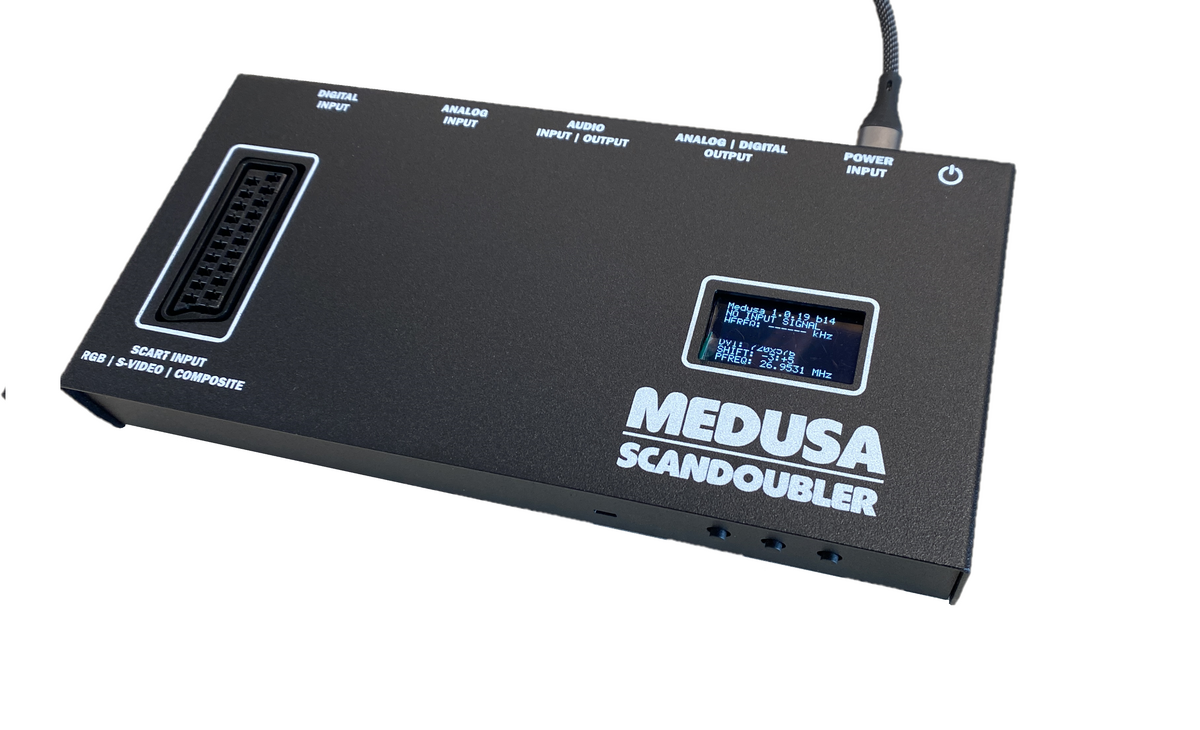
Please, check our SMD/THT services - smd.lotharek.pl; from idea to ready devices
Please, check our SMD/THT services - smd.lotharek.pl; from idea to ready devices

Medusa rev. B vs rev. A changes:
THIS IS JP21 VERSION !
NOT SCART EU VERSION !
( https://www.retrogamingcables.co.uk/euroscart-versus-jp21)
Connecting SCART in EU STANDART MAY DAMAGE YOUR DEVICE !
Medusa is here; after many experiments with framemeister, OSSC and others, we decided to make quantum leap ahead all competition and make sth MUCH BETTER :-).. and to be honest - WE DID IT !
Medusa project was started 6-7 years ago, when 2 people - old retro stuff geeks have met - Acidmaker (creator of Sio2sd and proffesional file system used at Harvard, Columbia university and many others) and me. Since very beginning Acidmaker was into gettting perfect picture from ATARI ST / ATARI 8bit / Amiga. Meanwhile, me (lotharek), as opposite side, was into simple usage, ergonomy and user friendly interface. After 5 long years of develomennt, many protototypes, hours of discussions/testing, thousands of euros spent (obviously...) we are very happy to announce, that final project is coming and it is about to be released in preorder for retro community soon.
What we are about to offer:
FUTURE PLANS:
Power supply:
Inputs:
Otput:
There are three buttons "left", "middle" and "right".
|
 |
Some history - 5 years at one picture :-))
First, please refer to offcial WIKI PAGE: http://medusa-sc.org/index.php?title=Main_Page
Q. Do you possibly have a manual or pin assignment for the SCART connection? Unfortunately, no information can be found on the website (Medusa).
A. MEDUSA`s SCART pinout is ...SCART STANDART and is widely described around the web. it can be found in many places; example: https://en.wikipedia.org/wiki/SCART
Most important informations below:
 |
|||
| Pin 1 | NOT USED AT MEDUSA | Audio output (right) | |
|---|---|---|---|
| Pin 2 | Audio input (right) | ||
| Pin 3 | NOT USED AT MEDUSA | Audio output (left/mono) | |
| Pin 4 | Audio ground (pins 1, 2, 3 & 6 ground) | ||
| Pin 5 | RGB Blue ground (pin 7 ground) | ||
| Pin 6 | Audio input (left/mono) | ||
| Pin 7 | RGB Blue up S-Video C down[a] Component PB up[b] |
||
| Pin 8 | NOT USED AT MEDUSA |
Status & Aspect Ratio up[c]
|
|
| Pin 9 | RGB Green ground (pin 11 ground) | ||
| Pin 10 | NOT USED AT MEDUSA | Clock / Data 2[d] Control bus (AV.link) |
|
| Pin 11 | RGB Green up Component Y up[b] |
||
| Pin 12 | NOT USED AT MEDUSA | Reserved / Data 1[d] | |
| Pin 13 | RGB Red ground (pin 15 ground) | ||
| Pin 14 | NOT USED AT MEDUSA | Usually Data signal ground (pins 8, 10 & 12 ground) | |
| Pin 15 | RGB Red up S-Video C up Component PR up[b] |
||
| Pin 16 |
Blanking signal up
|
||
| Pin 17 | Composite video ground (pin 19 & 20 ground) | ||
| Pin 18 | Blanking signal ground (pin 16 ground) | ||
| Pin 19 | NOT USED AT MEDUSA | Composite video output S-Video Y output |
|
| Pin 20 | Composite video input S-Video Y input |
||
| Pin 21 | Shell/Chassis[e] | ||
Q. Hi, i’ve recently recieved my medusa and i was wondering if there is a discord or forum (I’ve seen the wiki) to join to help in testing and reporting with various computers and consoles as i have a few. From X68000 to CDi .
A: we think about this to develp further firmware revisions. Meanhwile help us sending fingerprints to Jakub Kruszona-Zawadzki <acid.maker@gmail.com>
http://medusa-sc.org/index.php?title=Menu#rgb_only
fingerprint - Medusa recognises input devices using "fingerprint" mechanism. For each device there is a predefined fingerprint in the firmware. But sometimes it may happen that your device is not recognised correctly, or it is not in Medusa's database at all. This option displays fingerprint parameters for currently connected device. These values may be used by Medusa developers to improve devices detection and adding new ones.
Q. Just tried my CPC6128 using the retrocomputershack scart cable. Medusa recognises the source as S-VIDEO which is incorrect, should be RGB and the image is very very dark.There doesn’t appear to be an option to change the source input from Component/Video/RGB ect.
A: Medusa will recognize rgb, when at 16 of scart is proper voltage. that is how scart standarts works. If You see svideo as detected signal , it means clerarly you do not switch Medusa`s scart to rgb mode. Only green and red signals are passed to Medusa... but inside not proper chip works with signal ( composite/svideo instead of vga/rgb). Your medusa led is GREEN. it shall be red when RGB is detected (WIKI). Modify cable to follow scart standart (amstrad cables need extra power to supply proper voltage) as CPC6128 doesnt supply voltage at video out connector. More at wiki:
https://www.cpcwiki.eu/index.php/File:CPC2SCART_-_RGB.jpg